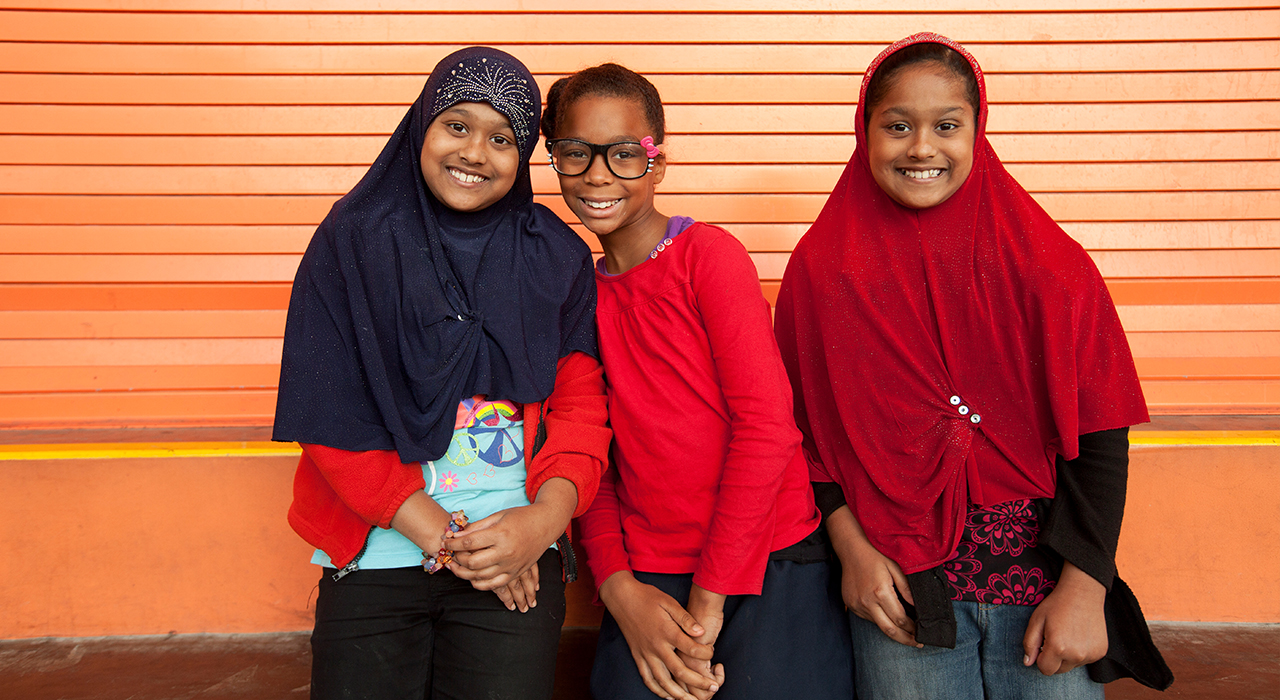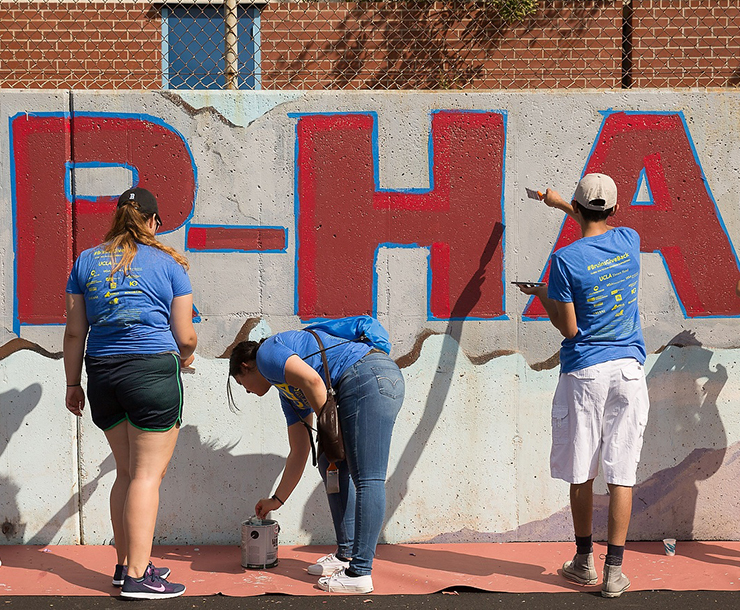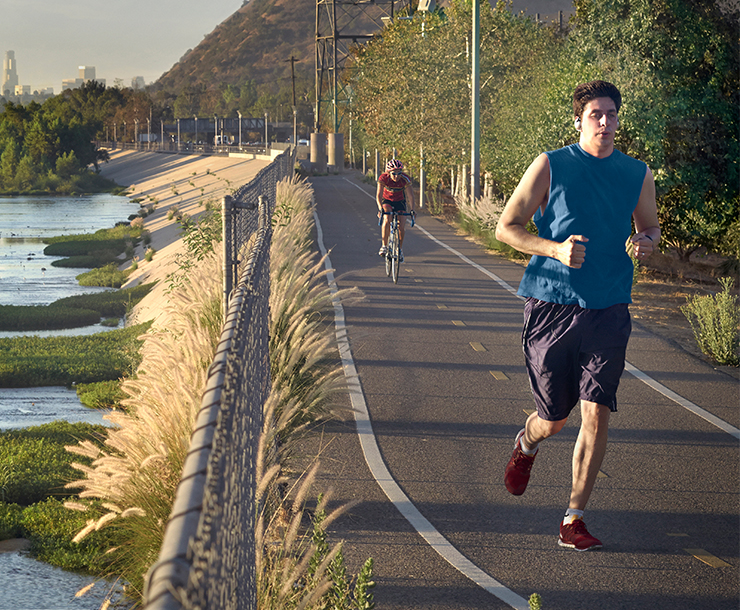When it comes to community and civic engagement, service is not just a word. It’s a mission. And nowhere is that mission embraced with more commitment than at UCLA.

Service is a hallmark of our university. Here, we never forget our obligation to help improve the lives of people in our community and around the world. Better schools, brighter futures, healthier communities, a sustainable city, thousands of Bruin volunteers spreading out across the city on one extraordinary day. In these and a myriad of other ways, UCLA is making a difference.
School Works
Eighth-grader Akili Woods, student body president at Horace Mann UCLA Community School in South L.A., says he’s learning about how to get to college and how to be a better person now that UCLA’s Graduate School of Education & Information Studies is partnering with his school through an innovative team-up with the Los Angeles Unified School District.
Woods, who hopes to attend UCLA and become a kindergarten teacher, says the curriculum at Mann has become more challenging, too, since UCLA came on board.
After years of declining enrollment at the school, fall 2017 opened with 415 students, including a new 9th grade. The population of the neighborhood is African-American and Latino, with only 6% of residents having college degrees.
The Mann School is UCLA’s second such effort to remake K–12 education. In fall 2009, the first UCLA Community School opened, as part of LAUSD’s Robert F. Kennedy Community Schools complex in Koreatown. The school now draws an enrollment of more than 1,000 mostly low-income Latino and Asian students from Koreatown and adjacent Pico-Union.
Students there not only receive an education in the basics but they also get to learn alongside university students and faculty who work and volunteer at the UCLA Community School. The results are clear: Last year, 99 percent of the school’s seniors gained college acceptance, and 75 percent enrolled — several points above the 68 percent of high school graduates nationally.
Serving Those Who Serve
In 2006, CNN interviewed Aaron Mankin, a young marine whose ears, nose and mouth were severely burned after his 26-ton amphibious assault vehicle rolled over an improvised explosive device in Iraq. When asked what was next for him, the soldier replied in a voice still raspy from inhaling fire, “I have some surgeries planned to fix the beautiful part.”
UCLA alumnus and philanthropist Ronald A. Katz and his wife, Maddie, were watching. The Katzes felt that these warriors deserved the best possible care, and they knew that Ronald Reagan UCLA Medical Center — where Katz was a board member — could help. A year later, the philanthropist’s efforts bore fruit. Operation Mend was born, a partnership between the UCLA Medical Center, Brooke Army Medical Center in San Antonio, Texas, and the Veterans Affairs Greater Los Angeles Healthcare System. Its first patient was Aaron Mankin.
While the original goal of Operation Mend was to give returning service members with severe facial injuries access to the Army’s best burn center and the nation’s best plastic and reconstructive surgeons, the program has since expanded to optimize the healing of body, mind and spirit of wounded warriors and their families. It is one of many ways that UCLA welcomes and supports veterans returning to their communities.
UCLA has been serving veterans for nearly 70 years, since the end of World War II. UCLA medical school faculty and residents provide care to 3,000 individual patients a year at the VA. Support available or on the way includes a center to help with or prevent homelessness, substance abuse and mental illness; a family resource center; and an entrepreneurial boot camp for disabled vets. In these and many other ways, we are proud to serve those who serve.
UCLA On Call
The list of UCLA community efforts related to healthcare is long and varied, a testament to its world-class medical and dental schools and its hospital, consistently ranked among the top 10 in America and the best in Southern California.
For example, the UCLA School of Nursing Health Clinic has provided primary health care services to the homeless and indigent population on Skid Row for more than a quarter of a century. Since 2000, the Mobile Clinic Project at UCLA has put dedicated public health, undergraduate, medical and law students on the road to serve the West Hollywood homeless population. Over time, student involvement has increased the availability of medications, referrals and health education to the neediest among us, and the program now also operates a homeless clinic in Santa Monica.
Meanwhile, more than 300 physicians and nurses, dentists from the UCLA School of Dentistry, ophthalmologists from the UCLA Stein Eye Institute and members of student groups recently volunteered their time and expertise at the free, three-day Care Harbor health clinic in Los Angeles. The clinic brings together community partners to care for thousands of uninsured, underinsured and at-risk people from across the region.
A Greenway Runs Through It
The L.A. River, which starts in the Simi Hills and meanders 51 miles to the Port of Long Beach, has been called one of Los Angeles’ most ill-used natural treasures. It’s also a neglected eyesore that looks more like a deserted freeway than a river. Now graduate student researchers and scholars at the Luskin Center, part of the UCLA Luskin School of Public Affairs, are working with stakeholders, communities and organizations in an attempt to create a new future for the river and its environs.
Adjoining the river is Marsh Park — 3.9 acres of greenway in the Elysian Valley neighborhood of Los Angeles, not far from downtown. The park features trees, green infrastructure, play and fitness equipment, a walking path, picnic tables and an open-air pavilion. Marsh Park is one of 14 case studies used by researchers from the UCLA Luskin Center for Innovation in their Los Angeles River Greenway Guide, which is available online.
Explains J.R. DeShazo, director of the Luskin Center for Innovation, “What we have tried to do is to identify successful examples of improvements in the river greenway and then identify the challenges and the obstacles that those improvements faced so that other communities can learn from their successes, challenges and, sometimes, their failures.”
Returning Service
Next month, thousands of Bruins will deploy throughout Los Angeles to more than 50 K–12 schools, food banks, parks, shelters, veterans’ facilities and neighborhood centers. It’s the 9th Annual UCLA Volunteer Day, the nation’s largest service project for new university students. Last year’s event included 7,200 volunteers and provided almost $1 million worth of service.
On Volunteer Day, new freshmen and transfer students join with undergraduates, graduate students, faculty, staff, alumni, parents and community members to participate in a wide range of community service projects across Los Angeles. They deliver critical infrastructure and beautification help, as well as mentorship support.
As a public university, UCLA was created to serve as well as educate. For almost a century, our students, faculty, alumni and every member of the Bruin family have worked tirelessly to help our communities. Because that’s the kind of service that really matters.

